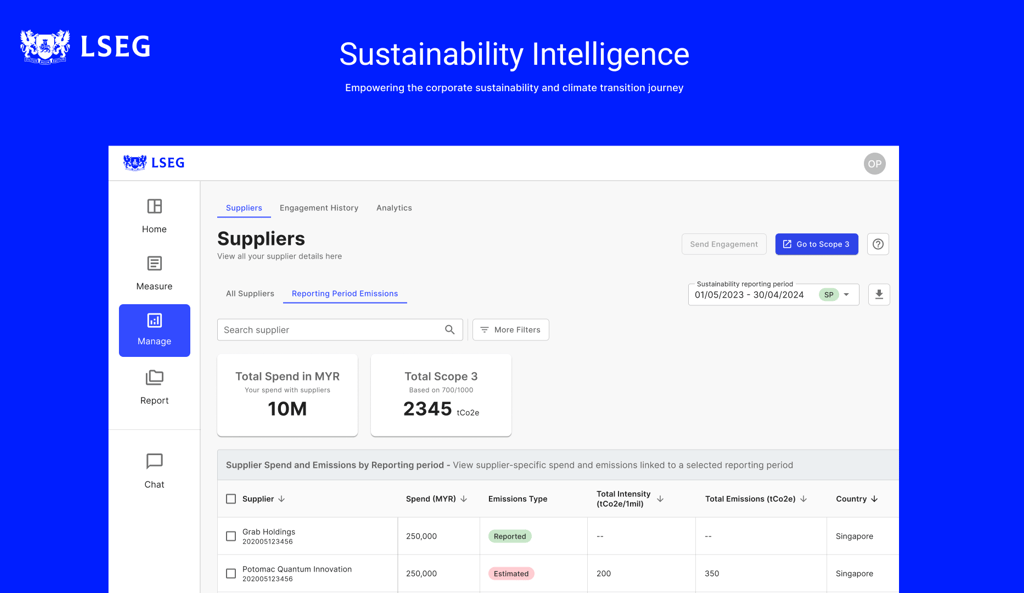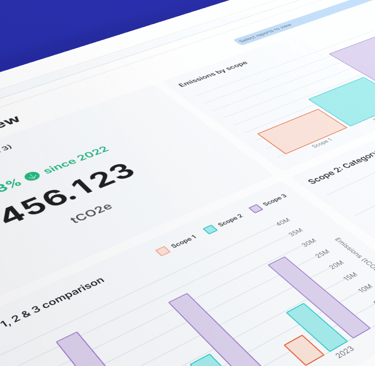Sustainability Intelligence - Building Scope 3 Ecosystems
Systems Thinking & Product Ecosystems- Where design, data, and product architecture intersect
SUPPLY CHAIN EMISSIONSSCOPE 3SUPPLIER MANAGEMENTRESEARCH
ROLE : PRODUCT MANAGER | UX RESEARCH LEAD
11/12/20253 min read
Sus-Intel is LSEG’s sustainability intelligence platform that helps financial institutions and corporates measure, manage, and report carbon emissions across their value chains — driving transparency, compliance, and data-driven climate action.
Project Overview
I led the end-to-end product development and design of LSEG’s Scope 3 Ecosystem - connecting supplier engagement, emissions estimation, data sharing, and reporting periods into one traceable, scalable system.
What began as fragmented tools became a unified climate reporting platform used by corporates and thousands of suppliers.
Scope 3 Emissions : Scope 3 represents the emissions a company doesn’t directly control but is responsible for across its supply chain — often 70–90% of total emissions.


Solution:
Reporting Periods: A time-anchoring layer that ties all emissions to the correct disclosure cycle.
Streamlined Scope 3 Estimation:
Created continuity between estimation cycles so corporates no longer need to re-upload full supplier listsConnected Supplier Engagement:
Linked engagements directly to supplier profiles, estimates, and reporting data, giving corporates a complete view of who has already shared information and what’s still pending.Built a Central Supplier Record:
Designed a persistent supplier database that stores supplier details and emissions history, engament historyEnabled Data Reuse & Sharing:
Introduced logic for suppliers to share previously reported data across multiple corporates, reducing duplicate survey requests and making the entire process more efficient.
MVP Highlights
Centralized supplier database
Engagement module with customizable surveys
Supplier account creation for direct data sharing
Reported vs Estimated Emissions data views
Activation analytics dashboard


The Problem
Scope 3 accounts for 70–90% of a company’s total emissions - The state of the platform when I joined:
No reporting periods, so emissions couldn’t be tied to any year or disclosure cycle.
Scope 3 estimation had to start from scratch every time with full supplier re-uploads.
Supplier engagement was disconnected from supplier profiles, estimates, and reporting.
No central supplier database — data couldn’t be reused or tracked across engagements.
Reported data couldn’t flow into analytics or be shared across corporates.
Suppliers received duplicate survey requests with no visibility or reuse of past submissions.
The Problem Statement
"How might we build a connected platform that enables corporates to seamlessly estimate, collect, and report Scope 3 emissions — aligning supplier and emissions data to reporting periods — so they can meet sustainability reporting requirements with accuracy, traceability, and trust?"
Timeline
Aug 2024 – Aug 2025
My Role
Product Manager for Supplier Management, Data Sharing, and Settings modules.
UX Lead ensuring unified flows and design consistency across all modules.
Collaborated with 2 PMs, 2 Data Architects, and 3 Engineering Squads to align product logic and delivery.
Drove end-to-end design and development of the Scope 3 Ecosystem, transforming Sus-Intel into an integrated sustainability platform.
Impact
318% growth — scaled participation from 184 to 900+ corporates in one year.
200+ active corporates post-revamp (up from ~60 before).
72.9% activation rate maintained across 180+ organisations.
Compliance-ready features aligned with regional disclosure standards.
Seamless onboarding boosted early activation across all user types.
Ecosystem foundation for new revenue streams, with modular subscriptions across Scope 3 estimation, supplier management, and data comparison.
Collaborated with Sales & Exchanges to run workshops and demos that accelerated onboarding and market adoption.



